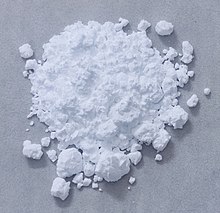Lutetium compounds
Lutetium compounds are compounds formed by the lanthanide metal lutetium (Lu). In these compounds, lutetium generally exhibits the +3 oxidation state, such as LuCl3, Lu2O3 and Lu2(SO4)3.[1] Aqueous solutions of most lutetium salts are colorless and form white crystalline solids upon drying, with the common exception of the iodide. The soluble salts, such as nitrate, sulfate and acetate form hydrates upon crystallization. The oxide, hydroxide, fluoride, carbonate, phosphate and oxalate are insoluble in water.[2]
Oxides

Halides
- 3 Lu
2S
3+ 20 HF + (2 + 2x) H
2O → 2 (H
3O)Lu
3F
10·xH
2O↓ + 9 H
2S↑ (x = 0.9) - (H3O)Lu3F10 → 3 LuF3 + HF↑ + H2O↑
Lutetium oxide and
- 2 Lu(s) + 3 Br2(g) → 2 LuBr3(s)
If burned, lutetium(III) bromide may produce hydrogen bromide and metal oxide fumes.[15] Lutetium(III) bromide reacts to strong oxidizing agents.[15] Lutetium(III) iodide can be obtained by reacting lutetium with iodine:[16][17]
- 2 Lu + 3 I2 → LuI3
Lutetium(III) iodide can also obtained by the reacting metallic lutetium with mercury iodide in vacuum at 500 °C:[16]
- 2 Lu + 3 HgI2 → 2 LuI3 + 3 Hg
The elemental
Coordination compounds
Nitrogen-containing ligand complexes
Lutetium phtalocyanine

Lutetium phthalocyanine is the most notable coordination compound of lutetium, and is derived from lutetium and two
2 is red, whereas the reduced form LuPc−
2 is blue and the next two reduced forms are dark blue and violet, respectively.[23] The green/red oxidation cycle can be repeated over 10,000 times in aqueous solution with dissolved alkali metal halides, before it is degraded by hydroxide ions; the green/blue redox degrades faster in water.[23]
Other complexes
[LuI2(HOiPr)4]I can be dissolved in pyridine-THF to give yellow [LuI(OiPr)(py)5]I. LuI3 is directly dissolved in pyridine-THF to obtain yellow [LuI2(py)5]I. In both compounds pyridine is coordinated to lutetium by nitrogen atom.[24] Lutetium(III) nitrate can be crystallized with 2,2':6',2-terpyridine (terpy) in dry acetonitrile to obtain colorless [Lu(terpy)(NO3)3], in which the nitrogen atom and the oxygen atom of the nitrate are coordinated to the lutetium atom.[25]
Oxygen-containing ligand complexes

Trivalent lutetium and
Other compounds
Adding
References
- ^ "Lutetium".
- ISBN 978-0-07-049439-8. Retrieved 2009-06-06.
- ^ a b Lutetium Oxide. 1997-2007. Metall Rare Earth Limited. http://www.metall.com.cn/luo.htm
- ^ Macintyre, J. E. (1992). Dictionary of Inorganic Compounds Volumes 1–3. London: Chapman & Hall.
- ^ Trotman-Dickenson, A. F. (1973). Comprehensive Inorganic Chemistry. Oxford: Pergamon.
- PMID 26698962.
- S2CID 101643906.
- ISBN 3-432-02328-6, p. 254.
- doi:10.1016/j.jfluchem.2017.12.001.)
{{cite journal}}: CS1 maint: multiple names: authors list (link - doi:10.1016/j.jfluchem.2012.12.013.)
{{cite journal}}: CS1 maint: multiple names: authors list (link - ISBN 0-8493-0594-2, retrieved 2008-06-27
- ^ "Lutetium(III) chloride hexahydrate 542075". Sigma-Aldrich. Retrieved 2019-07-24.
- ISBN 0-19-855370-6
- ^ Winter, Mark. "Lutetium»reactions of elements [WebElements Periodic Table]". www.webelements.com. Retrieved 22 December 2016.
- ^ a b "Lutetian bromide" (PDF). SDS. Retrieved 22 December 2016.
- ^ a b c Georg Brauer (Hrsg.), unter Mitarbeit von Marianne Baudler u. a.: Handbuch der Präparativen Anorganischen Chemie. 3., umgearbeitete Auflage. Band I, Ferdinand Enke, Stuttgart 1975, ISBN 3-432-02328-6, S. 1077.
- ^ Webelements: Lutetium: lutetium triiodide Retrieved 31.3.2018
- ^ Asprey, L. B.; Keenan, T. K.; Kruse, F. H. Preparation and crystal data for lanthanide and actinide triiodides. Inorg. Chem., 1964. 3 (8): 1137-1240
- ^ 无机化学丛书 第七卷 钪 稀土元素. 科学出版社. pp 211
- ^ .
- ^ .
- ^ PMID 23802970.
- ^ doi:10.1039/A905248H.
- )
- doi:10.1039/b200480c. Retrieved 2022-12-29.)
{{cite journal}}: CS1 maint: multiple names: authors list (link - S2CID 245712597. Retrieved 2022-12-29.)
{{cite journal}}: CS1 maint: multiple names: authors list (link - S2CID 100903579.)
{{cite journal}}: CS1 maint: multiple names: authors list (link - ^ a b 无机化学丛书. pp 206. 1.3.3 氧化态+3的化合物.
- ISSN 0044-2313. Retrieved 2022-12-29.
